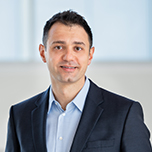BMEN Departmental Seminar
This special seminar will feature our four newest faculty members who will give an overview of their research.

Microfluidic Platforms to Quantify Immune Cell Decision-Making Phenotypes
Caroline N. Jones
ABSTRACT: There are over ten trillion cells in the human immune system. Revolutionary single-cell technologies have led to the profound discovery that there is more heterogeneity within specific immune cell populations than previously thought. The Jones laboratory focuses on engineering novel microfluidic platforms to enable fundamental research on the dynamics of immune-pathogen interactions with single-cell resolution. This work is interdisciplinary involving aspects of microfabrication, surface engineering, biomaterials, biosensors, computational modeling, and immunology/molecular biology to define and quantify principal factors that underlie the decision-making processes of immune cell migration, differentiation and activation in response to challenges. Dr. Jones will present brief overviews of three research themes from her laboratory: 1) Lab-on-a-chip platforms to detect immune cell dysfunction during sepsis; 2) On-chip biosensors to study immune cell-pathogen interactions with single-cell precision and to screen novel immunotherapies. 3) 3D hydrogel platforms to precisely control and quantify the effects of the microenvironment on cell phenotypes. The engineering tools developed in the Jones Laboratory, can be applied to study basic mechanisms and roles of immune cells in inflammatory disorders, including sepsis and cancer. Immunotherapies are on the cutting-edge of treating many diseases. The devices created in the Jones Laboratory will be able to screen and evaluate the basic mechanisms of therapies in a high-throughput manner as well as monitor patient immune response.

Optically-active nanotherapies: traceable and personalizable approaches for cancer management
Girgis Obaid
ABSTRACT: Cancer nanotherapies are currently limited by their complex in vivo behavior and unpredictable interactions with tumors in side the body. As such, the focus of the molecular Imaging and Optical Nanotherapeutic (mION) Group at UT Dallas Bioengineering, is to capitalize on cutting edge quantitative molecular imaging approaches in order to ultimately personalize cancer nanotherapies on a patient-by-patient basis. The optically-active nanotherapies we develop in our group use external light triggers (LED, lasers etc) to initiate treatment through a modality known as photodynamic therapy – at the right place and the right time. The ultimate goal of our approaches are to maximize the benefits of anti-cancer treatments for patients, whilst minimizing unwanted side effects. This multidisciplinary effort relies on collaborations with experts in nanotechnology, bioimaging, cancer therapy and immunotherapy.

Tissue Mechanics and Remodeling in Disease Progression
Jacopo Ferruzzi
ABSTRACT:Cardiovascular disease and cancer represent the two leading causes of mortality in the United States. Despite inherent differences, both diseases initiate and progress via interconnected biomechanical, biophysical, and mechanobiological factors, including extracellular matrix (ECM) remodeling, cell-matrix interactions, and altered cell metabolism. In this seminar, I will showcase integrated multi-scale approaches that I have developed to investigate tissue mechanics and remodeling in health and disease. In particular, I will discuss recent work aimed at unveiling the complex relationship between ECM structure, mechanics, and collective breast cancer invasion. The utility of these approaches in the context of vascular disease and wound healing will be briefly discussed. The ultimate goal is to gain a better understanding of disease to develop new diagnostic markers and therapeutic strategies.

Advanced optical imaging and computational analysis for developmental cardiac mechanics
Yichen Ding
ABSTRACT: The ability to image cardiac morphogenesis in real-time and in 3-dimensions (3-D) remains an optical challenge. The advent of light-sheet fluorescence microscopy (LSFM) has advanced developmental biology and cardiac regeneration research. I will introduce our in-house LSFM system in which the illumination lens reshapes a thin light-sheet to rapidly scan across a sample of interest while the detection lens orthogonally collects the imaging data. This multiscale strategy provides deep-tissue penetration, high-spatiotemporal resolution, and minimal photobleaching and phototoxicity, allowing in vivo visualization of a variety of tissues and processes, ranging from developing hearts in live zebrafish embryos to ex vivo interrogation of the microarchitecture of optically cleared neonatal hearts. To extend my research on the comprehensive exploration of advanced imaging and computational methods, I will further introduce our hybrid platform regarding LSFM and virtual reality (VR) for an interactive and immersive microenvironment. This platform along with machine learning-based image processing (Saak transform) enables us to recapitulate developmental cardiac mechanics and physiology with high spatiotemporal resolution. Given a specific example, I will demonstrate our displacement analysis of myocardial mechanical deformation (DIAMOND) to quantify doxorubicin-induced myocardial injury and regeneration in zebrafish model.




